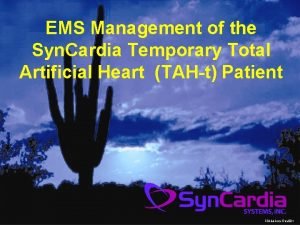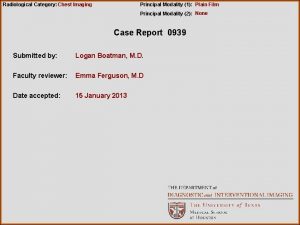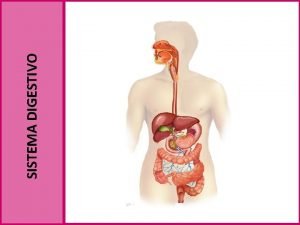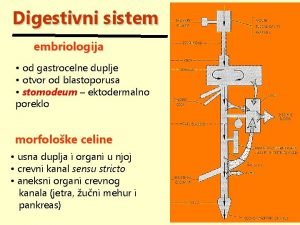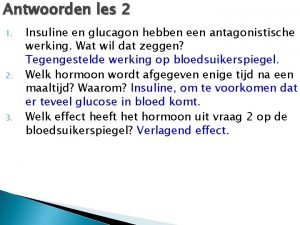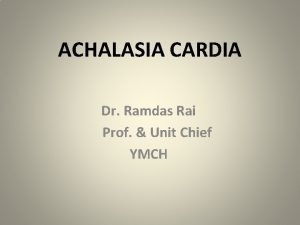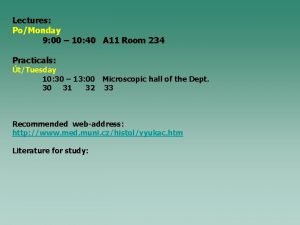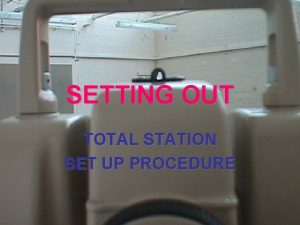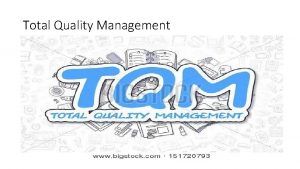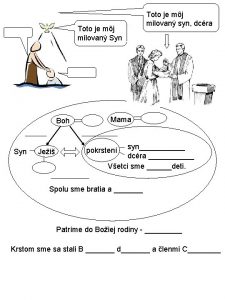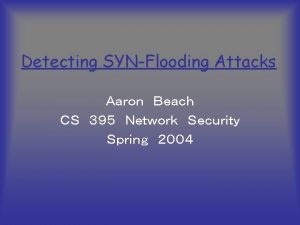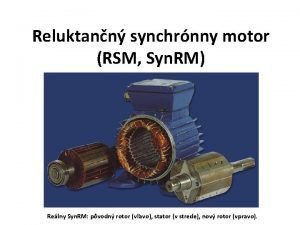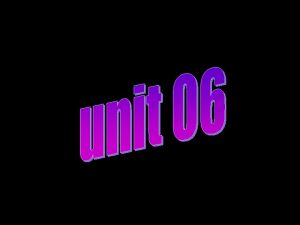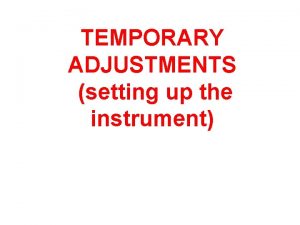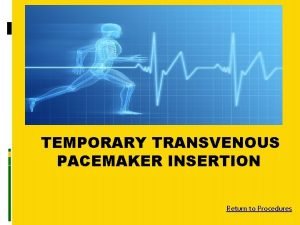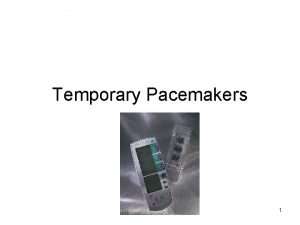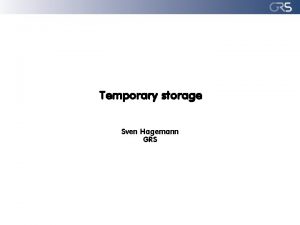EMS Management of the Syn Cardia Temporary Total




















- Slides: 20

EMS Management of the Syn. Cardia Temporary Total Artificial Heart (TAH-t) Patient Clinical-xxx Rev 001

Overall Goal of TAH-t Impant To serve as a bridge to heart transplantation for patients at imminent risk of death from biventricular failure by providing hemodynamic stability and adequate organ perfusion

Syn. Cardia TAH System FDA PMA October 2004 Clinical Intro -362 Rev 007 Rev 3

Implantable TAH Features • Both Right and Left Ventricles Removed Outflow • All 4 Heart valves excised • Atria left behind Inflow • 70 cc Prime Volume • 27 mm Inflow • 25 mm Outflow Right Left • Same blood flow pathway as native heart Clinical Intro -362 Rev 007 Rev 4

Differences between TAH patients and LVAD patients TAH patients WILL have a pulse, LVAD patients Usually WILL NOT TAH patients WILL NOT have a Cardiac Rhythm, Whereas LVAD patients WILL

Operate TAH § Partial § Full Fill Eject Clinical Intro -362 Rev 007 Rev 6



Clinical Relevance in the Field 1) TAH PATIENTS WILL HAVE A PULSE BUT NOT A EKG!!!!! 2) NO CARDIAC MONITOR NEEDED FOR EKG 3) BP CUFF IS ALL THE MONITORING THAT IS NEEDED 4) CPR INEFFECTIVE ON TAH PATIENTS 5) VASOPRESSORS MUST NOT BE GIVEN TO PATIENT IN THE FIELD 6) VASODILATORS MORE BENEFICIAL IN FIELD THAN VASOPRESSORS, PT MAY HAVE RESCUE MED (SL NITRO ETC…) 7) CONTACT VAD COORDINATOR AT HOSPITAL FOR APPROPRIATE CARE INSTRUCTIONS 8) TRANSPORT PATIENTS ASAP TO IMPLANTING HOSPITAL, INTUBATE IF NEEDED 9) CHECK FREQUENTLY THE CARDIAC OUTPUT AND FILL VOLUMES ON FREEDOM DRIVER

Exploded View of the Freedom Driver System Clinical-490 Rev 002 10

Freedom Driver Parts Clinical-490 Rev 002 11

Connecting to External Power via the AC Power Supply connected to wall power outlet AC Power Supply connected to Power Adaptor • Plug the green connector from the AC Power Supply into the Power Adaptor green receptacle • Plug one end of the AC Power Supply Cord into the AC Power Supply and the other end of the cord to a grounded wall power outlet in ambulance Green light illuminated on Power Adaptor • Confirm that the green light on the AC Power Supply and the Power Adaptor is illuminated Clinical-490 Rev 002 12

Checking Onboard Battery Charge Battery Fuel Gauge Display Window Rate, Fill Volumes, Cardiac Output • Press the Battery Charge Button • The Battery Fuel Gauge will show green lights on top of the Onboard Battery Charge Button • Each light illuminated represents approximately 20% charge Display Window Push Button • All five lights illuminated indicate approximately 81% to 100% charge Clinical-490 Rev 002 13

Freedom Driver Alarms § Three Types of Alarms § § Each Alarm indicated by: § § § Battery Alarm Temperature Alarm Fault Alarm Visual Alarm and Audible Alarm Do not ignore Alarms No way to mute Alarms The issue that caused the alarm must be immediately addressed Clinical-490 Rev 002 14

Battery Alarm Indicated by: • Beeping tone Audible Alarm and • Blinking yellow light Visual Alarm. Click on speaker icon to hear Battery Alarm Clinical-490 Rev 002 15

Battery Alarm ALARM Battery Alarm HEAR Loud Intermittent Tone SEE Yellow Battery LED flashing MEANING WHAT YOU SHOULD DO One or both of the Onboard Batteries have less than 35% remaining charge (only two green lights display on the Battery Fuel Gauge) Replace each low Onboard Battery, one at a time, with a charged Onboard Battery or connect to external power (NOTE: Once the batteries are charged above 35% the Battery Alarm will stop) Onboard Battery is incorrectly installed Reinsert Onboard Battery until locked in place. If Battery Alarm continues, insert a new Onboard Battery One Onboard Battery is missing Insert a charged Onboard Battery into Freedom Driver until locked in place Clinical-490 Rev 002 16

Temperature Alarm Indicated by: • Beeping tone Audible Alarm and • Blinking red light Visual Alarm Click on speaker icon to hear Temperature Alarm Clinical-490 Rev 002 17

Temperature Alarm ALARM Temperature Alarm HEAR Loud Intermitt ent Tone SEE Red Alarm LED flashing MEANING WHAT YOU SHOULD DO The internal temperature of the Driver is too hot Remove any objects that are blocking the Filter Cover and / or Fan and check filter The temperature of the Onboard Batteries is too hot or too cold Move the Freedom Driver to a cooler or warmer area Clinical-490 Rev 002 18

Fault Alarm Indicated by: • Constant tone Audible Alarm and • Solid red light Visual Alarm Click on speaker icon to hear Fault Alarm Clinical-490 Rev 002 19

Fault Alarm ALARM HEAR SEE MEANING Valsalva Maneuver: Strenuous coughing or laughing, vomiting, straining during a bowel movement, or lifting a heavy weight Fault Alarm Loud Continuous Tone Red Alarm LED solid WHAT YOU SHOULD DO Relax/interrupt valsalva maneuver Kinked or disconnected drivelines Straighten or connect drivelines Driver is connected to External Power without at least one correctly inserted Onboard Battery Insert a charged Onboard Battery into Freedom Driver until locked in place One or both of the Onboard Batteries have less than 30% remaining charge Replace each low Onboard Battery, one at a time, with a charged Onboard Battery or connect to external power. (NOTE: the Fault Alarm will continue and will change into a Battery Alarm as the Onboard Batteries recharge. Once the Onboard Batteries are charged above 35%, the Battery Alarm will stop) Malfunction of the Driver If the above steps do not stop the Fault Alarm, switch to Backup Freedom Driver. Return to implant 20 hospital. Clinical-490 Rev 002
 Syn cardia
Syn cardia Syn cardia
Syn cardia Syn cardia
Syn cardia Pengertian sejarah dalam bahasa yunani
Pengertian sejarah dalam bahasa yunani Piloro e cardia
Piloro e cardia Egzokrini sistem
Egzokrini sistem Achalasia of cardia
Achalasia of cardia Cardia gaster
Cardia gaster Achalasia cardia
Achalasia cardia Brandy cardia
Brandy cardia Cardiomyotomy definition
Cardiomyotomy definition Cardia
Cardia Cardia ventriculi
Cardia ventriculi Station set up
Station set up Ciclo de servicio de una aerolinea
Ciclo de servicio de una aerolinea Total revenues minus total costs equals
Total revenues minus total costs equals Total revenues minus total costs equals
Total revenues minus total costs equals Total revenues minus total costs equals
Total revenues minus total costs equals Total revenue minus total expenses
Total revenue minus total expenses Contemporary management theory ppt
Contemporary management theory ppt Operations management with total quality management book
Operations management with total quality management book

